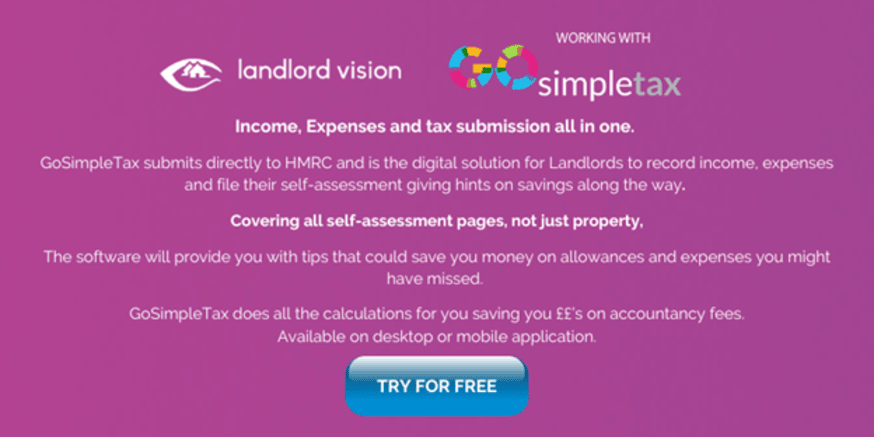
April 6, and that can mean only one thing – the start of the new UK tax year. It’s when most changes to UK tax rules come into force, which can be good or bad news for you and your rental income. It can also be the perfect time to make tax less of a hassle and look for ways to reduce your tax bill.
So, what key tax changes are planned from 6 April 2023 and how could they impact you? GoSimpleTax tells us more in this guest article.
Income Tax Changes You Should Know About
1.
On 6 April 2023, the Income Tax additional rate threshold (ART) will fall from £150,000 to £125,140. When you earn £125,140 or more a year, you don’t get the £12,570 standard Personal Allowance (PA), because £1 of the PA is taken away for every £2 of your income that’s above £100,000.
According to HMRC: “From 2023 to 2024, this measure will impact around 792,000 taxpayers, of whom around 232,000 will pay the additional rate of tax who would not have done so had this threshold [remained] at £150,000.”
● For those with income between £125,140 and £150,000, the average cash loss is £621 in 2023/24, says HMRC.
● For those with income above £150,000, the average cash loss is £1,256 in 2023/24, according to HMRC.
2.
The additional rate of tax will remain at 45% in England, Wales and Northern Ireland, but it will rise from 46% to 47% in Scotland (the higher rate of Income Tax in Scotland will also go up from 41% to 42%), which won’t be welcome news for higher-earning landlords in Scotland.
Capital Gains Tax Changes You Should Know About
3.
If you sell property after 6 April 2023, you could well pay thousands of pounds more Capital Gains Tax (CGT). That’s because the annual exempt amount (AEA – how much gain you can make after disposing of an asset before CGT is due) will fall from £12,300 to £6,000 in 2023/24.
● You could pay many thousands more from 6 April 2024, because the AEA will again be reduced to just £3,000 in 2024/25 for individuals (trustees get half of the two exemption figures stated).
Need to know! After the AEA is accounted for, basic rate Income Tax payers pay 18% CGT on gains made from selling residential property (10% on gains from other chargeable assets). Higher rate Income Tax payers pay 28% CGT on gains made from selling residential property (20% on gains from other chargeable assets).
Dividend Allowance Changes You Should Know About
4.
From 6 April 2023, the Dividend Allowance will be reduced to £1,000 (it’s been £2,000 since April 2018), which is the amount you can earn in dividend payments before tax is payable. The Dividend Allowance will again be halved in April 2024, falling to just £500.
The amount of tax you pay on dividend income above the dividend allowance, after the Personal Allowance, depends on your Income Tax band:
● Basic rate (£12,571 to £50,270 taxable income) = 8.75%.
● Higher rate (£50,271 to £125,140 taxable income after 6 April) = 33.75%.
● Additional rate (over £125,140 taxable income from 6 April) = 39.35%.
If you own property and receive dividends from your property company, obviously, these changes are more likely to directly affect you. However, they may or may not be relevant if you pay Income Tax on rental income via Self Assessment but also receive dividend income from shares that you own.
Stamp Duty Changes You Should Know About
5.
Landlords planning to buy another property, holiday home or buy-to-let property for more than £40,000 will need to pay an additional 3% on each tier of stamp duty in England and Northern Ireland, and an additional 4% in Wales and Scotland.
In England and NI in the 2023/24 tax year that equates to:
Property Price and Stamp Duty Rate
| Up to £250,000 | 3% |
| £250,001- £925,000 | 8% |
| £925,001-£1.5m | 13% |
| More than £1.5m | 15% |
Overseas buyers must pay a 2% surcharge on top of the normal Stamp Duty rates, as well as a 3% buy-to-let surcharge. So, for holiday homes or buy-to-let properties, if you’re an overseas buyer you’ll pay 5% more than the standard rate for UK nationals.
Need to know! The Stamp Duty threshold will fall back down to £125,000 from March 2025. It was doubled in the September 2022 mini-Budget.
Making Tax Digital Changes You Should Know About
6.
HMRC has delayed introducing Making Tax Digital for Income Tax (MTD for ITSA). It was planned for introduction from April 2024, for sole traders and landlords with a taxable income of more than £10,000, which may have encouraged many landlords to voluntarily start complying with MTD requirements this year.
However, the first phase of MTD for ITSA won’t now be introduced until April 2026 and will only impact those with taxable income of more than £50,000 a year. Further phases of introduction are planned after April 2026.
How will MTD for ITSA change reporting requirements?
● Under MTD for ITSA, landlords must maintain digital records of their income and expenses and digitally send a quarterly summary to HMRC using MTD-compatible software (or bridging software that enables compliance with MTD reporting requirements while using existing accounting software).
● At the end of the year, landlords must digitally submit a statement to HMRC, confirming the figures they’ve submitted, with any accounting adjustments made.
● They must also make a final declaration, confirming any other income received. When introduced, many landlords won’t need to complete an annual Self Assessment tax return.
Time to file your Self assessment tax return?
You can file your 2022-23 Self Assessment tax return any time from 6 April 2023. According to HMRC, 66,465 2021/22 Self Assessment tax returns were filed on 6 April 2022 (almost double the 36,939 Self Assessment tax returns filed on 6 April 2018). You don’t have to be such an early bird, of course, but the sooner you do it, the better.
Need to know! Apart from enabling you to avoid the annual headache that can result from leaving your Self Assessment tax return until January, with the online filing deadline looming on midnight 31st, getting it done earlier means you can find out much sooner whether you’re due a tax rebate.




